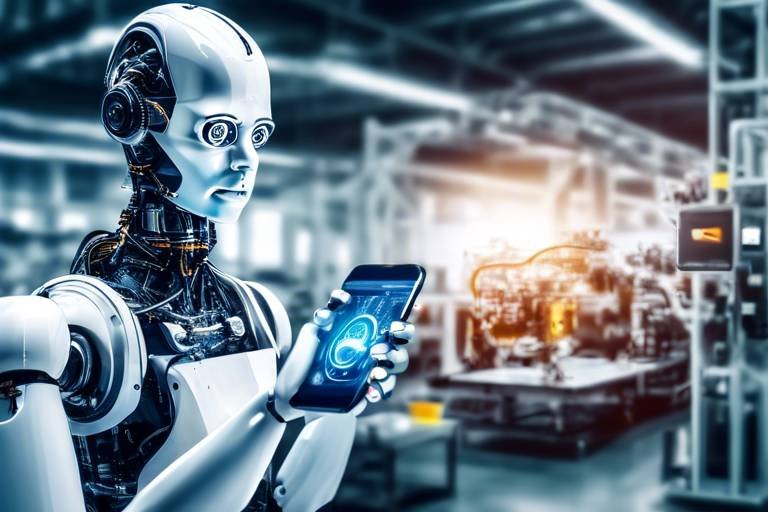Revolution in Retail with Artificial Intelligence
Artificial Intelligence (AI) is no longer just a buzzword; it’s a transformative force that is reshaping the retail landscape in ways we never thought possible. Imagine walking into a store where every interaction feels personalized, where your preferences are anticipated, and where shopping becomes an experience tailored just for you. This is the new reality brought forth by AI. Not only is it enhancing customer experiences, but it’s also optimizing supply chains and driving innovative practices that improve business efficiency and profitability.
In today’s fast-paced world, consumers demand speed, convenience, and personalization. Retailers are responding by integrating AI technologies into their operations. From smart algorithms that predict trends to chatbots that provide instant support, AI is revolutionizing how retailers operate and interact with their customers. The result? A shopping experience that is not only enjoyable but also highly efficient.
Let’s dive deeper into how AI is changing the game in retail. We’ll explore its impact on customer experiences, supply chain management, and the exciting future trends that are on the horizon. Buckle up, because the revolution in retail is just getting started!
At its core, AI in retail refers to the use of advanced technologies to analyze data and automate processes. This includes machine learning, natural language processing, and data analytics. Retailers are harnessing these technologies to enhance traditional practices, making them more efficient and customer-centric. For instance, AI can analyze vast amounts of data to identify shopping patterns, allowing retailers to adapt their strategies accordingly. This not only helps in improving sales but also in creating a seamless shopping experience.
Moreover, AI can facilitate real-time decision-making. Imagine a retailer being able to adjust their inventory based on current sales trends and customer preferences, all thanks to AI insights. This level of adaptability is crucial in today’s competitive market, where consumer preferences can shift overnight. As we explore further, you’ll see how these AI applications lead to more informed decisions and better customer relationships.
One of the most exciting aspects of AI in retail is its ability to enhance customer interactions. AI tools are revolutionizing how retailers engage with their customers, offering personalized recommendations and improving service responsiveness. This leads to higher customer satisfaction and loyalty. But how exactly does this work? Let’s break it down.
Retailers are leveraging AI to create tailored shopping experiences. By utilizing data analytics, they can understand customer preferences and behavior, driving sales and engagement. For example, consider how Netflix recommends shows based on your viewing history. Retailers can apply similar strategies to suggest products based on past purchases, browsing behavior, and even social media activity. This level of personalization makes customers feel valued and understood, fostering a deeper connection with the brand.
Predictive analytics is another powerful AI application that allows retailers to anticipate customer needs and trends. By analyzing historical data, retailers can make proactive decisions about inventory management and marketing strategies. For instance, if data shows that a particular product is gaining popularity, retailers can stock up before demand spikes. This not only ensures that customers find what they’re looking for but also reduces the risk of lost sales.
AI-powered chatbots and virtual assistants are becoming commonplace in retail. These tools provide instant customer support, enhancing service efficiency while freeing up human resources for more complex inquiries. Imagine having a virtual shopping assistant available 24/7 to answer questions, suggest products, or even help you track your order. This level of accessibility not only improves customer satisfaction but also builds trust in the brand.
Data is the new oil, and AI is the refinery. By facilitating data collection and analysis, AI empowers retailers to make informed decisions that enhance their operational strategies and market positioning. With AI, retailers can sift through mountains of data to identify trends, customer preferences, and potential areas for improvement. This data-driven approach allows retailers to stay ahead of the competition and adapt quickly to changing market conditions.
AI plays a critical role in streamlining supply chain processes, from inventory management to logistics. By automating these processes, retailers can ensure efficiency and reduce operational costs. This is particularly important in an era where consumers expect fast and reliable service.
AI algorithms help retailers optimize inventory levels, reducing excess stock and minimizing shortages. This not only improves overall profitability but also ensures that customers can find what they want when they want it. Imagine a store that never runs out of your favorite item because AI is constantly monitoring stock levels and predicting demand.
AI enhances logistics operations by predicting delivery times and optimizing routes. This leads to reduced costs and improved customer satisfaction through timely deliveries. With AI, retailers can analyze traffic patterns, weather conditions, and other variables to ensure that products arrive on time, every time.
The future of retail is bright, thanks to emerging AI technologies and trends that are set to further revolutionize the industry. As we look ahead, it’s clear that AI will continue to shape the future of shopping experiences.
Augmented reality (AR) is becoming a game-changer in retail. It allows customers to visualize products in their environment before making a purchase. Imagine trying on clothes virtually or seeing how a piece of furniture looks in your living room. This not only enhances engagement but also reduces returns, as customers are more likely to be satisfied with their purchases.
Retailers are utilizing AI to create targeted marketing campaigns based on consumer behavior insights. This results in higher engagement rates and improved conversion metrics. By understanding what drives their customers, retailers can craft messages that resonate, leading to more effective marketing strategies.
- What is AI in retail? AI in retail refers to the use of advanced technologies to enhance customer experiences, streamline operations, and optimize inventory management.
- How does AI improve customer experience? AI improves customer experience by providing personalized recommendations, instant support through chatbots, and predictive analytics to anticipate customer needs.
- What are the benefits of AI in supply chain management? AI optimizes inventory levels, enhances logistics operations, and reduces operational costs, leading to improved efficiency and customer satisfaction.
- What future trends can we expect in AI retail? Future trends include augmented reality shopping, AI-driven marketing campaigns, and further advancements in personalization and data analytics.

Understanding AI in Retail
This article explores how artificial intelligence is transforming the retail landscape, enhancing customer experiences, optimizing supply chains, and driving innovative practices that improve business efficiency and profitability.
Artificial Intelligence, or AI, is not just a buzzword; it's the driving force behind a seismic shift in the retail sector. Imagine walking into a store where the shelves seem to know your preferences better than you do. That's the magic of AI! At its core, AI refers to the simulation of human intelligence in machines that are programmed to think and learn like humans. In retail, this translates to smarter decision-making, personalized shopping experiences, and streamlined operations.
One of the most exciting aspects of AI in retail is its ability to analyze vast amounts of data in real-time. Retailers can gather information from various sources, including customer purchases, social media interactions, and even website browsing habits. This data becomes the backbone of AI applications, allowing businesses to tailor their offerings to meet customer demands effectively.
Let's break down some of the key applications of AI in retail:
- Personalized Shopping Experiences: AI algorithms analyze customer data to provide tailored recommendations, making shopping more enjoyable and efficient.
- Inventory Management: AI helps retailers maintain optimal stock levels, predicting what products will be in demand and when.
- Customer Service: AI-powered chatbots offer instant support, answering questions and resolving issues without human intervention.
Furthermore, AI technologies such as machine learning and natural language processing are revolutionizing how retailers interact with their customers. For instance, machine learning algorithms can identify patterns in customer behavior, enabling retailers to anticipate future purchases. This predictive capability not only enhances the shopping experience but also boosts sales by ensuring that popular items are always in stock.
In addition to enhancing customer interactions, AI also plays a pivotal role in operational efficiency. Retailers can automate routine tasks, allowing staff to focus on more complex customer needs. This not only improves the overall service quality but also reduces operational costs significantly.
To illustrate the impact of AI in retail, consider the following table that highlights some notable AI applications and their benefits:
| AI Application | Benefits |
|---|---|
| Personalized Marketing | Increases customer engagement and conversion rates |
| Predictive Analytics | Improves inventory management and forecasting |
| Customer Service Chatbots | Provides 24/7 support and reduces wait times |
| Dynamic Pricing | Optimizes pricing strategies based on demand |
In summary, understanding AI in retail is crucial for anyone looking to navigate the future of shopping. As AI continues to evolve, it will undoubtedly lead to even more innovative solutions that enhance both customer satisfaction and operational efficiency. The future of retail is here, and it’s powered by artificial intelligence!
Q: What is Artificial Intelligence in retail?
A: AI in retail refers to the use of machine learning, data analytics, and automation to improve customer experiences and streamline operations.
Q: How does AI enhance customer experience?
A: AI enhances customer experience by providing personalized recommendations, improving service responsiveness, and automating customer support through chatbots.
Q: What are the benefits of AI in supply chain management?
A: AI optimizes inventory levels, predicts delivery times, and enhances logistics operations, leading to reduced costs and improved efficiency.
Q: Will AI replace human jobs in retail?
A: While AI will automate certain tasks, it is more likely to augment human roles, allowing employees to focus on more complex and value-added activities.

Enhancing Customer Experience
In today's fast-paced retail environment, customer experience has become a key differentiator for businesses looking to thrive. With the advent of artificial intelligence (AI), retailers are now equipped with powerful tools that can significantly enhance how they interact with their customers. Imagine walking into a store where the staff knows your name, remembers your previous purchases, and offers tailored recommendations just for you. This is not a distant dream; it's the reality that AI is creating in the retail landscape.
AI tools are revolutionizing customer interactions in retail, offering personalized recommendations and improving service responsiveness. By analyzing vast amounts of data, AI can identify patterns and preferences, enabling retailers to craft experiences that resonate with individual shoppers. For instance, if a customer frequently buys organic products, AI systems can suggest similar items or alert them to new arrivals in that category. This level of personalization not only enhances the shopping experience but also fosters customer loyalty.
Retailers are leveraging AI to create tailored shopping experiences, utilizing data analytics to understand customer preferences and behavior. This means that every interaction is informed by the customer's history and preferences. For example, an online clothing store can analyze a shopper's past purchases and browsing history to recommend outfits that complement their style. This targeted approach drives sales and engagement, as customers are more likely to purchase items that feel personally curated for them.
Moreover, the use of predictive analytics allows retailers to anticipate customer needs and trends. By analyzing data from various sources, including social media and past purchase behavior, AI can forecast what products will be in demand. This enables retailers to proactively manage inventory and marketing strategies, aligning them with consumer demand. Imagine a scenario where a retailer knows that a particular item will be popular during the holiday season; they can prepare in advance to ensure they have enough stock on hand.
Another exciting development in enhancing customer experience is the rise of AI-powered chatbots and virtual assistants. These digital helpers provide instant customer support, answering questions and resolving issues around the clock. This not only enhances service efficiency but also frees up human resources for more complex inquiries. Customers appreciate the immediacy of responses, which can significantly improve their overall shopping experience. With chatbots handling routine queries, human staff can focus on building relationships and addressing more intricate customer needs.
AI facilitates data collection and analysis, empowering retailers to make informed decisions that enhance their operational strategies and market positioning. By continuously monitoring customer interactions and feedback, retailers can refine their approaches and adapt to changing consumer preferences. This data-driven mindset is essential for staying competitive in an ever-evolving market. Retailers can use insights gained from AI to implement strategies that not only meet but exceed customer expectations.
As AI continues to evolve, the potential for enhancing customer experience will only grow. Retailers who embrace these technologies will find themselves at the forefront of innovation, creating shopping experiences that are not only efficient but also deeply personalized. The future of retail is bright, and it’s powered by the intelligent insights that AI provides.
- How does AI enhance customer experience in retail?
AI enhances customer experience by providing personalized recommendations, improving service responsiveness, and utilizing chatbots for instant support. - What are personalization strategies in retail?
Personalization strategies involve using data analytics to tailor shopping experiences based on individual customer preferences and behavior. - Can AI predict customer needs?
Yes, AI can analyze past behaviors and trends to predict future customer needs, allowing retailers to adjust inventory and marketing strategies accordingly. - What role do chatbots play in retail?
Chatbots provide instant customer support, answering questions and resolving issues, which improves service efficiency and customer satisfaction.

Personalization Strategies
In today's fast-paced retail environment, personalization has become a crucial strategy for businesses aiming to stand out. Gone are the days of one-size-fits-all marketing; instead, retailers are now harnessing the power of artificial intelligence to create tailored shopping experiences that resonate with individual customers. Imagine walking into a store where the sales associate knows your name, your preferences, and even your past purchases—this is the magic of AI-driven personalization.
Retailers are leveraging data analytics to delve deep into customer behavior and preferences. By analyzing shopping patterns, browsing history, and even social media interactions, businesses can create a comprehensive profile for each customer. This data-driven approach allows retailers to offer personalized product recommendations that feel almost intuitive. For example, if a customer frequently buys running shoes, the retailer can suggest the latest fitness gear or even send targeted promotions for upcoming sales on athletic wear. This not only enhances the shopping experience but also drives engagement and boosts sales.
Furthermore, AI technologies enable retailers to implement dynamic pricing strategies. By analyzing market trends, competitor pricing, and customer demand, retailers can adjust prices in real-time to ensure they remain competitive while maximizing profit margins. This level of responsiveness is impossible without the sophisticated algorithms that AI provides.
Another exciting aspect of personalization is the rise of recommendation engines. These AI systems analyze vast amounts of data to predict what products a customer might be interested in, effectively curating a unique shopping experience. For instance, when you browse an online store, you might see a section labeled "Recommended for You," showcasing items specifically chosen based on your previous interactions. This not only simplifies the shopping process but also increases the likelihood of conversion, as customers are presented with options that genuinely appeal to them.
To further illustrate the impact of personalization, consider the following table that summarizes key benefits of AI-driven personalization strategies:
| Benefit | Description |
|---|---|
| Enhanced Customer Engagement | By offering tailored recommendations, retailers can keep customers interested and engaged. |
| Increased Sales | Personalized experiences lead to higher conversion rates and increased average order values. |
| Improved Customer Loyalty | When customers feel understood and valued, they are more likely to return. |
| Efficient Marketing | Targeted marketing campaigns based on customer insights yield better results. |
In conclusion, the integration of AI into personalization strategies is not just a trend; it's a revolution in the retail sector. By understanding and anticipating customer needs, retailers can create a shopping experience that is not only enjoyable but also efficient and profitable. As technology continues to evolve, the possibilities for personalization are limitless, paving the way for a future where every shopping experience feels uniquely crafted for the individual.
- What is AI personalization in retail? AI personalization in retail refers to the use of artificial intelligence to tailor shopping experiences based on individual customer data and behavior.
- How does AI improve customer engagement? AI improves customer engagement by providing personalized recommendations and targeted marketing campaigns that resonate with customers' preferences.
- Can small retailers benefit from AI personalization? Absolutely! Even small retailers can leverage AI tools to enhance customer experiences and drive sales through personalized strategies.

Predictive Analytics
Predictive analytics is like having a crystal ball for retailers—one that’s powered by data. Imagine being able to foresee trends, understand customer needs, and optimize inventory levels before issues arise. This technology leverages historical data, statistical algorithms, and machine learning techniques to predict future outcomes. For instance, by analyzing past purchasing behaviors, retailers can tailor their inventory and marketing strategies to align with what customers are likely to want next. It's akin to having a personal shopper who knows your tastes and preferences perfectly!
One of the most significant advantages of predictive analytics is its ability to enhance inventory management. Retailers can avoid the pitfalls of overstocking or understocking—two situations that can severely affect profitability. By accurately forecasting demand, businesses can ensure that they have just the right amount of stock on hand. This not only reduces waste but also enhances customer satisfaction by ensuring popular items are available when needed. For example, a clothing retailer might analyze seasonal trends to stock up on winter wear just before the cold weather hits.
Moreover, predictive analytics empowers retailers to craft targeted marketing campaigns that resonate with their audience. By understanding when customers are likely to make purchases, businesses can time their promotions perfectly. This proactive approach can lead to increased sales and customer loyalty. Imagine receiving a personalized discount just when you're considering buying that new gadget—this is the magic of predictive analytics at work!
To illustrate the impact of predictive analytics, consider the following table that summarizes key benefits:
| Benefit | Description |
|---|---|
| Improved Inventory Management | Reduces excess stock and minimizes shortages by accurately forecasting demand. |
| Enhanced Customer Insights | Identifies trends and preferences, allowing for personalized marketing and product offerings. |
| Increased Sales | Optimizes promotional timing and product availability, leading to higher conversion rates. |
| Operational Efficiency | Streamlines supply chain processes by predicting needs and aligning resources accordingly. |
In conclusion, predictive analytics is not just a trend; it’s a vital tool that can revolutionize how retailers operate. By harnessing the power of data, businesses can stay one step ahead, ensuring that they meet customer demands efficiently and effectively. It's like having a well-tuned engine that drives the retail machine forward, making sure every part runs smoothly and contributes to overall success.
- What is predictive analytics? Predictive analytics involves using historical data and statistical algorithms to forecast future events and trends.
- How can predictive analytics benefit retailers? It helps optimize inventory, enhances customer insights, and increases sales by aligning marketing strategies with consumer behavior.
- Is predictive analytics expensive to implement? While there may be initial costs, the long-term benefits often outweigh the investment, leading to increased profitability.
- Can small retailers use predictive analytics? Absolutely! Many tools are available that cater to businesses of all sizes, making it accessible for small retailers.

Chatbots and Virtual Assistants
In today's fast-paced retail environment, customer service is more important than ever, and that's where come into play. These AI-powered tools are revolutionizing the way businesses interact with their customers, providing instant support and assistance around the clock. Imagine walking into a store and having a knowledgeable assistant ready to answer your questions without making you wait in line—this is the kind of experience chatbots offer, but in the digital realm.
Chatbots are designed to engage with customers through text or voice, answering queries, guiding them through the shopping process, and even helping with product recommendations. This not only enhances the shopping experience but also significantly reduces the workload on human staff. Think of chatbots as the friendly store clerks who never take a break. They can handle multiple customers simultaneously, ensuring that no one feels neglected.
Moreover, virtual assistants can be integrated into various platforms, such as websites, social media, and messaging apps, making them accessible wherever customers are. For example, if a customer is browsing a retail website late at night and has a question about a product, a chatbot can provide immediate answers, ensuring that the customer does not leave the site frustrated. This leads to higher conversion rates and ultimately boosts sales.
Here are some key benefits of using chatbots and virtual assistants in retail:
- 24/7 Availability: Customers can get assistance any time of day, which is especially beneficial for online retailers.
- Cost Efficiency: Reducing the need for large customer service teams can lead to significant savings.
- Instant Responses: Quick answers to customer inquiries can enhance satisfaction and loyalty.
- Data Collection: Chatbots can gather valuable data on customer preferences and behaviors, which can be analyzed for future marketing strategies.
As technology continues to advance, the capabilities of chatbots and virtual assistants will only improve. They will become more intuitive, able to understand complex queries, and provide even more personalized responses. Retailers who embrace these innovations will not only enhance their customer service but also gain a competitive edge in an ever-evolving market.
In conclusion, chatbots and virtual assistants are not just a trend; they are a fundamental shift in how retail businesses operate. By leveraging these tools, retailers can create a seamless and engaging shopping experience that meets the demands of modern consumers. As we move forward, it will be exciting to see how these technologies evolve and further transform the retail landscape.
Q1: What are chatbots?
A1: Chatbots are AI-powered programs that can simulate conversation with users, providing instant support and information.
Q2: How do chatbots improve customer service?
A2: They offer 24/7 assistance, provide quick responses, and can handle multiple inquiries at once, enhancing overall customer satisfaction.
Q3: Can chatbots collect customer data?
A3: Yes, chatbots can gather valuable insights on customer preferences and behaviors, which can be used for targeted marketing strategies.
Q4: Are chatbots expensive to implement?
A4: While there is an initial investment, chatbots can lead to significant cost savings by reducing the need for large customer service teams.

Data-Driven Decision Making
In today's fast-paced retail environment, the ability to make data-driven decisions is more crucial than ever. Retailers are no longer relying on gut feelings or outdated practices; instead, they are harnessing the power of artificial intelligence (AI) to collect, analyze, and interpret vast amounts of data. This transformation allows businesses to gain insights that were previously unimaginable. Imagine having a crystal ball that reveals customer preferences, market trends, and inventory levels in real-time—this is what AI offers to retailers.
By utilizing advanced data analytics, retailers can identify patterns in consumer behavior, which helps them tailor their offerings to meet customer needs more effectively. For instance, AI can analyze purchase histories, social media interactions, and even web browsing habits to create a comprehensive profile of each customer. This level of understanding enables retailers to personalize marketing efforts, ensuring that the right message reaches the right person at the right time.
Moreover, data-driven decision-making extends beyond just understanding customers. It also involves optimizing operational strategies. Retailers can use AI to assess supply chain performance, predict demand fluctuations, and manage inventory levels more efficiently. For example, if data indicates that a particular product is trending, retailers can proactively adjust their inventory to avoid stockouts. This not only enhances customer satisfaction but also boosts sales and profitability.
To illustrate how data-driven decision-making can impact various aspects of retail, consider the following table:
| Aspect | Traditional Approach | Data-Driven Approach |
|---|---|---|
| Customer Insights | Surveys and feedback forms | Real-time data analysis from multiple sources |
| Inventory Management | Manual tracking and reorder points | AI algorithms predicting demand and optimizing stock levels |
| Marketing Strategies | Broad campaigns with limited targeting | Personalized campaigns based on consumer behavior |
As retailers continue to embrace AI and data analytics, they are not just improving their operational efficiency; they are also fostering a culture of innovation and adaptability. This shift allows them to respond swiftly to market changes and consumer demands, which is essential in an industry that is constantly evolving. In essence, data-driven decision-making powered by AI is not just a trend; it is becoming the backbone of successful retail strategies.
In conclusion, the integration of AI into data-driven decision-making processes is revolutionizing the retail landscape. Retailers who leverage these technologies can expect to see enhanced customer satisfaction, improved operational efficiency, and ultimately, a stronger bottom line. As we move forward, the question is not whether to adopt these practices, but how quickly can businesses adapt to stay competitive in this rapidly changing market?
- What is data-driven decision making?
Data-driven decision making refers to the process of making decisions based on data analysis rather than intuition or personal experience. - How does AI contribute to data-driven decision making in retail?
AI analyzes large sets of data to identify patterns and trends, helping retailers make informed decisions regarding inventory, marketing, and customer engagement. - What are the benefits of using AI in retail?
Benefits include enhanced customer satisfaction, improved operational efficiency, and increased profitability through better inventory management and personalized marketing strategies.

Optimizing Supply Chain Management
In today's fast-paced retail environment, optimizing supply chain management has become more critical than ever. With the integration of artificial intelligence (AI), retailers are not only enhancing their operational efficiency but also ensuring that they meet customer demands promptly and effectively. Imagine a well-oiled machine that predicts your needs before you even realize them—that's the power of AI in supply chain management!
AI technologies are revolutionizing the way retailers manage their supply chains by providing predictive insights, automating processes, and improving overall decision-making. For instance, AI algorithms analyze vast amounts of data to forecast demand trends, helping retailers maintain optimal inventory levels. This proactive approach reduces excess stock and minimizes shortages, ultimately leading to enhanced profitability. Think of it as having a crystal ball that allows you to see what your customers will want next week or even next month!
Moreover, AI-driven solutions offer remarkable inventory management capabilities. By employing machine learning techniques, retailers can track inventory in real-time and adjust their stock levels accordingly. This not only ensures that popular items are always available but also helps in identifying slow-moving products that might need promotional strategies to boost sales. The result? A more agile and responsive supply chain that adapts to changing market dynamics.
Another significant advantage of AI in supply chain management is its impact on logistics and distribution. AI systems can optimize delivery routes by analyzing traffic patterns, weather conditions, and customer locations. This means that deliveries are not only faster but also more cost-effective. Retailers can save on fuel costs and reduce their carbon footprint while improving customer satisfaction through timely deliveries. Imagine receiving your package not just on time, but earlier than expected—now that's a delightful surprise!
To illustrate the transformative effects of AI on supply chain management, consider the following table that highlights the key benefits:
| Benefit | Description |
|---|---|
| Predictive Analytics | Anticipates customer demand and trends for proactive inventory management. |
| Real-Time Inventory Tracking | Enables retailers to maintain optimal stock levels and reduce excess inventory. |
| Optimized Delivery Routes | Improves logistics efficiency by minimizing delivery times and costs. |
| Enhanced Customer Satisfaction | Ensures timely deliveries and better service, leading to increased loyalty. |
In summary, the integration of AI into supply chain management is not just a trend; it's a necessity for retailers looking to thrive in an increasingly competitive landscape. By leveraging AI technologies, businesses can streamline their operations, reduce costs, and ultimately provide a better shopping experience for their customers. As we look to the future, it’s clear that those who embrace these innovations will lead the way in the retail revolution.
- What is the role of AI in supply chain management?
AI helps retailers optimize inventory levels, predict customer demand, and enhance logistics operations, leading to improved efficiency and cost savings.
- How does AI improve customer satisfaction in retail?
By ensuring timely deliveries and personalized shopping experiences, AI enhances overall customer satisfaction and loyalty.
- Can AI help reduce operational costs?
Yes, AI optimizes various processes in the supply chain, leading to significant reductions in operational costs through improved efficiency.

Inventory Management Solutions
In today's fast-paced retail environment, effective inventory management is crucial for maintaining profitability and customer satisfaction. With the advent of artificial intelligence, retailers are now equipped with sophisticated tools that can analyze vast amounts of data to optimize their inventory levels. Imagine having a system that not only tracks your stock but also predicts future demand based on trends, seasonal changes, and even social media buzz. This is where AI comes into play, transforming the way businesses handle their inventory.
AI algorithms can analyze historical sales data, customer preferences, and market trends to provide retailers with actionable insights. For instance, if a particular product is trending on social media, the AI system can alert the retailer to increase stock levels before the demand peaks. This proactive approach not only minimizes the risk of stockouts but also helps in reducing excess inventory, which can tie up valuable resources.
Moreover, AI-driven inventory management solutions often incorporate machine learning capabilities that continuously improve their predictions over time. This means that the more data the system processes, the better it becomes at forecasting demand. Retailers can leverage these insights to make informed decisions about when to reorder products, how much to order, and which items to promote during specific seasons.
To illustrate the impact of AI on inventory management, consider the following table that outlines the key benefits:
| Benefit | Description |
|---|---|
| Reduced Stockouts | AI predicts demand accurately, ensuring that popular items are always in stock. |
| Minimized Excess Inventory | By analyzing trends, retailers can avoid overstocking items that may not sell. |
| Improved Cash Flow | Efficient inventory management leads to better cash flow as less money is tied up in unsold stock. |
| Enhanced Customer Satisfaction | Customers are more likely to return when they find the products they want in stock. |
Additionally, AI can assist in automating reorder processes, which can save retailers significant time and effort. Instead of manually tracking inventory levels and placing orders, AI systems can automatically trigger reorders based on predefined thresholds. This not only streamlines operations but also allows staff to focus on more critical tasks, such as enhancing customer service or strategizing marketing efforts.
In conclusion, AI-powered inventory management solutions are revolutionizing how retailers approach stock control. By leveraging predictive analytics and machine learning, businesses can optimize their inventory levels, reduce costs, and ultimately improve their bottom line. As the retail landscape continues to evolve, those who embrace these innovative technologies will undoubtedly gain a competitive edge.
- What is AI in inventory management?
AI in inventory management refers to the use of artificial intelligence technologies to optimize stock levels, predict demand, and automate reorder processes, thereby enhancing efficiency and profitability.
- How does AI help reduce stockouts?
AI analyzes historical data and market trends to forecast demand accurately, allowing retailers to stock popular items before they run out.
- Can AI improve customer satisfaction?
Yes, by ensuring that products are available when customers want them, AI enhances the shopping experience and encourages repeat business.
- Is implementing AI in inventory management expensive?
The initial investment can vary, but the long-term savings and efficiency gained from AI typically outweigh the costs.

Logistics and Distribution
In the fast-paced world of retail, are pivotal to ensuring that products reach customers efficiently and effectively. With the integration of artificial intelligence (AI), retailers are witnessing a significant transformation in how they manage their supply chains. AI technologies are not just enhancing operational efficiency; they are also revolutionizing the customer experience by ensuring timely deliveries and optimizing routes.
One of the standout features of AI in logistics is its ability to predict delivery times with remarkable accuracy. By analyzing historical data, traffic patterns, and weather conditions, AI algorithms can forecast when a package will arrive at its destination. This predictive capability allows retailers to set realistic expectations for their customers, ultimately leading to increased satisfaction and trust.
Moreover, AI plays a crucial role in optimizing delivery routes. Traditional methods often relied on human intuition and experience, which could lead to inefficiencies and increased costs. However, with AI, retailers can utilize advanced algorithms that analyze multiple variables to determine the fastest and most cost-effective routes for delivery trucks. This not only reduces fuel consumption and operational costs but also minimizes the carbon footprint of logistics operations, aligning with the growing demand for sustainability in retail.
To illustrate the impact of AI on logistics, consider the following table that outlines the key benefits of AI in logistics and distribution:
| Benefit | Description |
|---|---|
| Improved Efficiency | AI streamlines processes, reducing the time taken for deliveries. |
| Cost Reduction | Optimized routes and predictive analytics lower operational costs. |
| Enhanced Customer Satisfaction | Accurate delivery predictions and timely service improve the customer experience. |
| Sustainability | Reduced fuel consumption contributes to environmentally friendly practices. |
Furthermore, AI can assist in inventory management within the logistics framework. By analyzing sales data and trends, AI systems can help retailers maintain optimal stock levels, preventing both overstock and stockouts. This proactive approach ensures that products are available when customers want them, reducing frustration and increasing sales opportunities.
In addition to these operational improvements, AI also enhances communication between retailers and their logistics partners. Real-time data sharing and updates allow for better collaboration and quicker responses to unforeseen challenges, such as delays or changes in demand. This agility is essential in today’s retail environment, where consumer expectations are higher than ever.
In summary, the integration of AI in logistics and distribution is not just a trend; it is a necessity for retailers looking to thrive in a competitive market. With the ability to predict delivery times, optimize routes, manage inventory effectively, and enhance communication, AI is reshaping the logistics landscape, ensuring that customers receive their products faster and more reliably than ever before.
- How does AI improve delivery accuracy?
AI analyzes various data points to predict delivery times accurately, taking into account factors like traffic and weather. - Can AI help reduce logistics costs?
Yes, by optimizing delivery routes and inventory levels, AI can significantly lower operational costs. - What role does AI play in inventory management?
AI helps retailers maintain optimal stock levels by analyzing sales trends and consumer demand. - Is AI in logistics environmentally friendly?
Absolutely! AI can reduce fuel consumption and improve overall efficiency, contributing to sustainable practices.

Future Trends in AI Retail
As we peer into the crystal ball of retail, it’s clear that artificial intelligence is not just a passing trend; it’s a seismic shift that’s reshaping the very fabric of the shopping experience. The future of AI in retail is brimming with potential, and it’s exciting to think about how these innovations will enhance our shopping journeys. One of the most thrilling developments on the horizon is Augmented Reality (AR). Imagine walking into a store and using your smartphone to visualize how a piece of furniture would look in your living room before you make a purchase. This immersive experience not only boosts engagement but also significantly reduces the likelihood of returns, as customers can make more informed decisions.
Moreover, the integration of AI-driven marketing campaigns is set to revolutionize how retailers connect with their customers. By harnessing the power of data analytics, retailers can create highly targeted marketing strategies based on individual consumer behavior. This means that instead of bombarding customers with generic ads, they’ll receive personalized promotions that resonate with their unique preferences. For instance, if a customer frequently browses athletic wear, they might receive exclusive offers on the latest sports gear. This level of personalization fosters a deeper connection between brands and consumers, leading to higher engagement rates and improved conversion metrics.
To illustrate the impact of these trends, let’s take a look at a comparison of traditional marketing versus AI-driven marketing:
| Aspect | Traditional Marketing | AI-Driven Marketing |
|---|---|---|
| Targeting | Broad audience | Highly personalized |
| Data Analysis | Limited insights | Real-time analytics |
| Adaptability | Slow to change | Dynamic and responsive |
| Customer Engagement | Generic messaging | Tailored promotions |
As we move further into the future, it’s also important to highlight the role of machine learning in enhancing customer service. AI-powered chatbots and virtual assistants are becoming increasingly sophisticated, capable of handling more complex inquiries and providing instant support. This not only improves service efficiency but also allows human staff to focus on more intricate customer needs, creating a more seamless shopping experience.
In summary, the future of AI in retail is poised to be transformative. With technologies like augmented reality and AI-driven marketing reshaping how we shop, retailers must stay ahead of the curve to meet evolving consumer expectations. The ultimate goal? To create a shopping experience that is not only efficient but also deeply engaging and personalized.
- What is Augmented Reality in retail? Augmented Reality (AR) allows customers to visualize products in their real-life environment using their smartphones or AR glasses before making a purchase.
- How does AI improve customer service? AI enhances customer service through chatbots and virtual assistants that provide instant support, resolving queries quickly and efficiently.
- What are AI-driven marketing campaigns? These campaigns use data analytics to create personalized marketing strategies based on consumer behavior, leading to higher engagement and conversion rates.
- Will AI replace human jobs in retail? While AI will automate certain tasks, it will also create new roles focused on managing and interpreting AI technologies, ultimately enhancing human capabilities.

Augmented Reality Shopping
Imagine walking into a store, but instead of navigating through aisles filled with products, you can simply point your smartphone at an empty space in your living room and see how a new sofa would look right there. This is the magic of Augmented Reality (AR) shopping, a revolutionary approach that's transforming the retail landscape. AR technology overlays digital information onto the real world, allowing customers to visualize products in their own environment before making a purchase. This innovative shopping experience not only enhances engagement but also significantly reduces the likelihood of returns, which can be a major headache for retailers.
Retailers are increasingly adopting AR solutions to provide customers with a more immersive shopping experience. For instance, furniture brands have developed apps that allow users to place 3D models of furniture in their homes. This way, shoppers can assess size, style, and color in real-time, making their decision-making process much easier. In fact, studies have shown that when customers can visualize a product in their own space, their confidence in the purchase increases dramatically. But how does this technology work?
At its core, AR shopping relies on a combination of smartphone cameras, computer vision, and machine learning. The camera captures the real-world environment, while computer vision analyzes the space to accurately place the digital product within it. Machine learning algorithms enhance this experience by learning from user interactions, continually improving the accuracy and relevance of the AR experience. Here are a few key benefits of AR shopping:
- Enhanced Customer Engagement: AR creates a fun and interactive shopping experience that captivates customers' attention.
- Reduced Product Returns: By allowing customers to visualize products in their own space, AR helps ensure they are satisfied with their choice before purchasing.
- Increased Sales: Engaging experiences can lead to higher conversion rates, as customers feel more confident in their purchases.
As AR technology continues to evolve, we can expect to see even more innovative applications in retail. From virtual fitting rooms that allow customers to try on clothes without ever stepping into a store, to makeup brands offering AR apps that let users see how different shades look on their skin, the possibilities are virtually endless. Retailers who embrace this technology will not only enhance the shopping experience but also position themselves as leaders in a rapidly changing market.
In conclusion, augmented reality shopping is not just a trend; it's a glimpse into the future of retail. As consumers increasingly seek personalized and interactive experiences, retailers who harness the power of AR will undoubtedly gain a competitive edge. So, the next time you think about shopping, consider how AR could change the way you interact with products, making your experience not only easier but also more enjoyable.
Q1: What is Augmented Reality shopping?
A1: Augmented Reality shopping is a technology that allows customers to visualize products in their own environment using digital overlays, typically through smartphone apps.
Q2: How does AR shopping reduce product returns?
A2: By allowing customers to see how products fit in their own space before purchasing, AR helps them make more informed decisions, leading to higher satisfaction and fewer returns.
Q3: What types of products can be visualized using AR?
A3: AR can be used for a wide range of products, including furniture, home decor, clothing, and cosmetics, enhancing the shopping experience across various retail sectors.
Q4: Do I need special equipment to use AR shopping apps?
A4: No special equipment is needed; most AR shopping experiences can be accessed through smartphones or tablets equipped with a camera.

AI-Driven Marketing Campaigns
In today's fast-paced retail environment, where consumer preferences can shift like sand, have emerged as a powerful tool for retailers looking to stay ahead of the curve. Imagine being able to tailor your marketing strategies to the unique behaviors and preferences of each customer. Sounds like magic, right? Well, with AI, it’s become a reality. By leveraging advanced algorithms and data analytics, retailers can create highly personalized marketing campaigns that resonate with their audience on a deeper level.
One of the most compelling aspects of AI in marketing is its ability to analyze vast amounts of data quickly and accurately. Retailers can harness this capability to segment their audience based on various factors such as purchasing history, browsing behavior, and even social media interactions. This segmentation allows for the creation of targeted campaigns that speak directly to the needs and desires of specific customer groups. For instance, a clothing retailer might use AI to identify customers who frequently purchase athletic wear and send them tailored promotions for new arrivals in that category.
Moreover, AI can optimize the timing and delivery of marketing messages. By analyzing when customers are most likely to engage with content—whether that’s through emails, social media posts, or advertisements—retailers can ensure their messages reach consumers at just the right moment. This level of precision can significantly enhance engagement rates, leading to increased sales and customer loyalty. For example, if AI determines that a particular customer tends to open emails on Saturday mornings, the retailer can schedule promotional emails to land in their inbox right at that time.
Additionally, AI-driven marketing campaigns can incorporate predictive analytics to forecast future buying behaviors. By understanding trends and patterns, retailers can proactively adjust their marketing strategies to align with anticipated consumer needs. This approach not only enhances the relevance of marketing efforts but also improves return on investment (ROI). For instance, if data indicates a surge in demand for eco-friendly products, a retailer can pivot their marketing focus to highlight sustainable options, ensuring they capture the attention of environmentally conscious shoppers.
To illustrate the impact of AI in marketing, consider the following table that outlines key benefits:
| Benefit | Description |
|---|---|
| Personalization | Creates tailored experiences for customers based on their preferences and behavior. |
| Improved Engagement | Increases interaction rates by delivering messages at optimal times. |
| Predictive Insights | Anticipates future trends and consumer needs to refine marketing strategies. |
| Higher ROI | Enhances the effectiveness of campaigns, resulting in better financial returns. |
As we look to the future, it's clear that AI-driven marketing campaigns will continue to evolve. Retailers who embrace these technologies not only gain a competitive edge but also foster stronger relationships with their customers. By delivering the right message to the right person at the right time, they can create a shopping experience that feels personal and engaging. So, are you ready to harness the power of AI in your marketing efforts?
- What is AI-driven marketing? AI-driven marketing uses artificial intelligence to analyze data and optimize marketing strategies for better targeting and personalization.
- How can AI improve customer engagement? AI can analyze customer behavior to determine the best times and channels for communication, increasing the likelihood of engagement.
- What role does predictive analytics play in AI marketing? Predictive analytics helps retailers forecast customer needs and trends, allowing them to adjust their marketing strategies proactively.
Frequently Asked Questions
- What is artificial intelligence in retail?
Artificial intelligence (AI) in retail refers to the use of advanced technologies to enhance various aspects of the retail business. This includes improving customer experiences, optimizing supply chains, and enabling data-driven decision-making. Think of AI as a smart assistant that helps retailers understand their customers better and streamline their operations.
- How does AI enhance customer experience?
AI enhances customer experience by providing personalized recommendations, improving service responsiveness, and offering instant support through chatbots. Imagine walking into a store where every item you see feels curated just for you—that's the magic of AI at work, making shopping more enjoyable and tailored to individual preferences.
- What are some examples of AI tools used in retail?
Some popular AI tools in retail include predictive analytics for anticipating customer needs, chatbots for customer support, and data analytics platforms for understanding shopping behaviors. These tools work together like a well-oiled machine, helping retailers make informed decisions and enhance their services.
- How does AI optimize supply chain management?
AI optimizes supply chain management by predicting inventory needs, enhancing logistics operations, and reducing operational costs. It's like having a crystal ball that helps retailers foresee challenges and opportunities, ensuring that products are available when and where customers want them.
- What future trends should we expect in AI retail?
Future trends in AI retail include augmented reality shopping experiences that allow customers to visualize products in their space, and AI-driven marketing campaigns that target consumers based on behavior insights. These innovations promise to make shopping even more interactive and personalized, keeping customers engaged and satisfied.
- Can AI really improve inventory management?
Absolutely! AI can significantly improve inventory management by analyzing sales data and predicting demand, which helps retailers maintain optimal stock levels. This means less wasted inventory and more satisfied customers, as products are more likely to be in stock when needed.
- Are AI chatbots effective for customer service?
Yes, AI chatbots are incredibly effective for customer service. They provide instant responses to inquiries, which enhances service efficiency. Think of them as the friendly store assistant who’s always available to help, allowing human staff to focus on more complex customer needs.



















